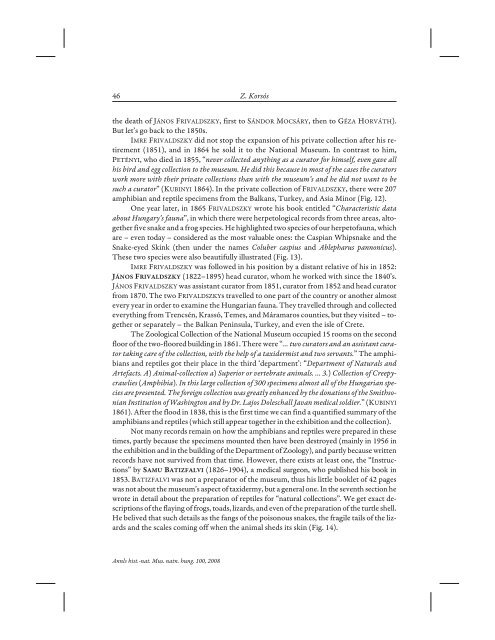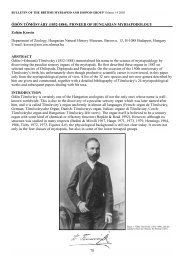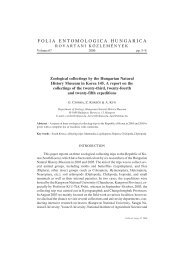History of the Herpetological Collection of the ... - Korsós Zoltán
History of the Herpetological Collection of the ... - Korsós Zoltán
History of the Herpetological Collection of the ... - Korsós Zoltán
Create successful ePaper yourself
Turn your PDF publications into a flip-book with our unique Google optimized e-Paper software.
46 Z. Korsós<br />
<strong>the</strong> death <strong>of</strong> JÁNOS FRIVALDSZKY, first to SÁNDOR MOCSÁRY, <strong>the</strong>n to GÉZA HORVÁTH).<br />
But let’s go back to <strong>the</strong> 1850s.<br />
IMRE FRIVALDSZKY did not stop <strong>the</strong> expansion <strong>of</strong> his private collection after his retirement<br />
(1851), and in 1864 he sold it to <strong>the</strong> National Museum. In contrast to him,<br />
PETÉNYI, who died in 1855, “never collected anything as a curator for himself, even gave all<br />
his bird and egg collection to <strong>the</strong> museum. He did this because in most <strong>of</strong> <strong>the</strong> cases <strong>the</strong> curators<br />
work more with <strong>the</strong>ir private collections than with <strong>the</strong> museum’s and he did not want to be<br />
such a curator”(KUBINYI 1864). In <strong>the</strong> private collection <strong>of</strong> FRIVALDSZKY, <strong>the</strong>re were 207<br />
amphibian and reptile specimens from <strong>the</strong> Balkans, Turkey, and Asia Minor (Fig. 12).<br />
One year later, in 1865 FRIVALDSZKY wrote his book entitled “Characteristic data<br />
about Hungary’s fauna”, in which <strong>the</strong>re were herpetological records from three areas, altoge<strong>the</strong>r<br />
five snake and a frog species. He highlighted two species <strong>of</strong> our herpet<strong>of</strong>auna, which<br />
are – even today – considered as <strong>the</strong> most valuable ones: <strong>the</strong> Caspian Whipsnake and <strong>the</strong><br />
Snake-eyed Skink (<strong>the</strong>n under <strong>the</strong> names Coluber caspius and Ablepharus pannonicus).<br />
These two species were also beautifully illustrated (Fig. 13).<br />
IMRE FRIVALDSZKY was followed in his position by a distant relative <strong>of</strong> his in 1852:<br />
(1822–1895) head curator, whom he worked with since <strong>the</strong> 1840’s.<br />
JÁNOS FRIVALDSZKY was assistant curator from 1851, curator from 1852 and head curator<br />
from 1870. The two FRIVALDSZKYs travelled to one part <strong>of</strong> <strong>the</strong> country or ano<strong>the</strong>r almost<br />
every year in order to examine <strong>the</strong> Hungarian fauna. They travelled through and collected<br />
everything from Trencsén, Krassó, Temes, and Máramaros counties, but <strong>the</strong>y visited – toge<strong>the</strong>r<br />
or separately – <strong>the</strong> Balkan Peninsula, Turkey, and even <strong>the</strong> isle <strong>of</strong> Crete.<br />
The Zoological <strong>Collection</strong> <strong>of</strong> <strong>the</strong> National Museum occupied 15 rooms on <strong>the</strong> second<br />
floor <strong>of</strong> <strong>the</strong> two-floored building in 1861. There were “… two curators and an assistant curator<br />
taking care <strong>of</strong> <strong>the</strong> collection, with <strong>the</strong> help <strong>of</strong> a taxidermist and two servants.” The amphibians<br />
and reptiles got <strong>the</strong>ir place in <strong>the</strong> third ‘department’: “Department <strong>of</strong> Naturals and<br />
Artefacts. A) Animal-collection a) Superior or vertebrate animals. … 3.) <strong>Collection</strong> <strong>of</strong> Creepycrawlies<br />
(Amphibia). In this large collection <strong>of</strong> 300 specimens almost all <strong>of</strong> <strong>the</strong> Hungarian species<br />
are presented. The foreign collection was greatly enhanced by <strong>the</strong> donations <strong>of</strong> <strong>the</strong> Smithsonian<br />
Institution <strong>of</strong> Washington and by Dr. Lajos Doleschall Javan medical soldier.”(KUBINYI<br />
1861). After <strong>the</strong> flood in 1838, this is <strong>the</strong> first time we can find a quantified summary <strong>of</strong> <strong>the</strong><br />
amphibians and reptiles (which still appear toge<strong>the</strong>r in <strong>the</strong> exhibition and <strong>the</strong> collection).<br />
Not many records remain on how <strong>the</strong> amphibians and reptiles were prepared in <strong>the</strong>se<br />
times, partly because <strong>the</strong> specimens mounted <strong>the</strong>n have been destroyed (mainly in 1956 in<br />
<strong>the</strong> exhibition and in <strong>the</strong> building <strong>of</strong> <strong>the</strong> Department <strong>of</strong> Zoology), and partly because written<br />
records have not survived from that time. However, <strong>the</strong>re exists at least one, <strong>the</strong> “Instructions”<br />
by<br />
(1826–1904), a medical surgeon, who published his book in<br />
1853. BATIZFALVI was not a preparator <strong>of</strong> <strong>the</strong> museum, thus his little booklet <strong>of</strong> 42 pages<br />
was not about <strong>the</strong> museum’s aspect <strong>of</strong> taxidermy, but a general one. In <strong>the</strong> seventh section he<br />
wrote in detail about <strong>the</strong> preparation <strong>of</strong> reptiles for “natural collections”. We get exact descriptions<br />
<strong>of</strong> <strong>the</strong> flaying <strong>of</strong> frogs, toads, lizards, and even <strong>of</strong> <strong>the</strong> preparation <strong>of</strong> <strong>the</strong> turtle shell.<br />
He belived that such details as <strong>the</strong> fangs <strong>of</strong> <strong>the</strong> poisonous snakes, <strong>the</strong> fragile tails <strong>of</strong> <strong>the</strong> lizards<br />
and <strong>the</strong> scales coming <strong>of</strong>f when <strong>the</strong> animal sheds its skin (Fig. 14).<br />
Annls hist.-nat. Mus. natn. hung. 100, 2008




